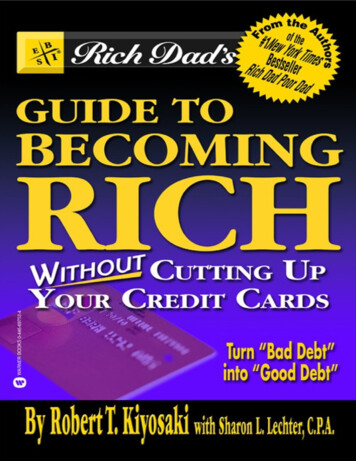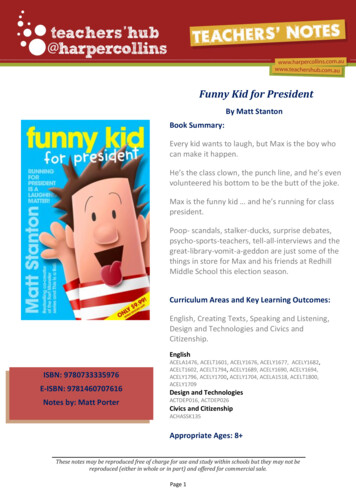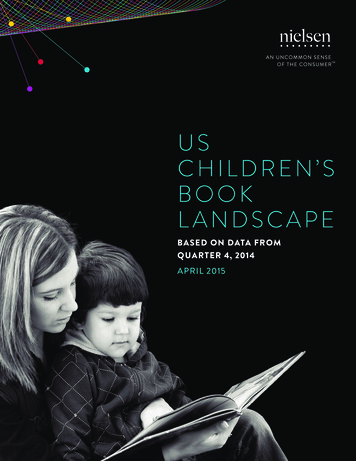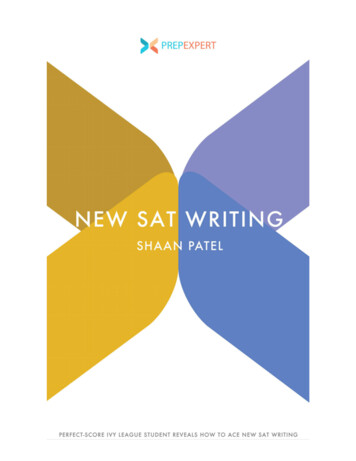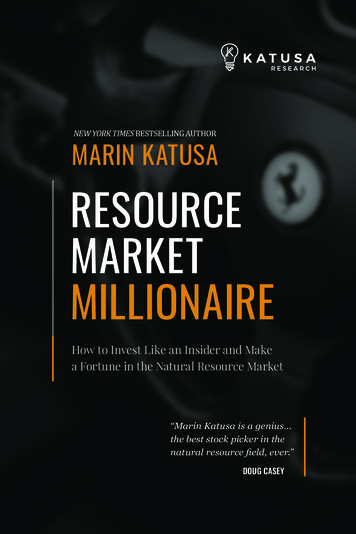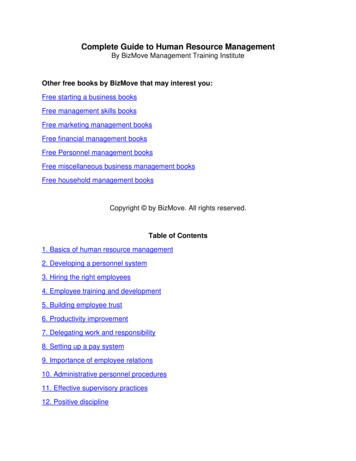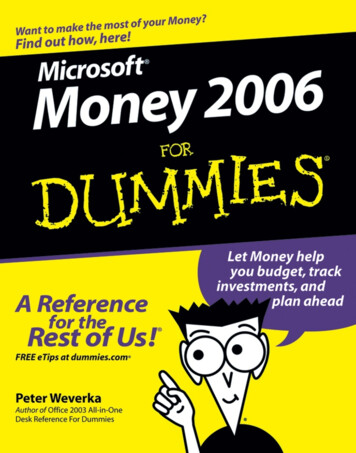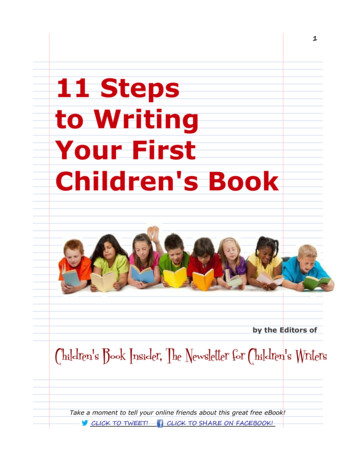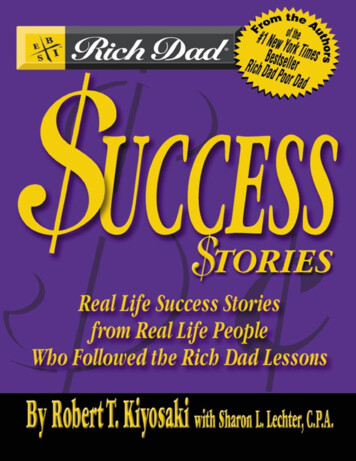
Transcription
Other Bestselling Books byRobert T. Kiyosaki & Sharon L. LechterRich Dad Poor DadWhat The Rich Teach Their Kids About Money That The Poor And MiddleClass Do NotRich Dad’s CASHFLOW QuadrantRich Dad’s Guide To Financial FreedomRich Dad’s Guide to InvestingWhat The Rich Invest In That The Poor And Middle Class Do NotRich Dad’s Rich Kid Smart KidGive Your Child A Financial Head StartRich Dad’s Retire Young Retire RichHow To Get Rich Quickly And Stay Rich ForeverRich Dad’s ProphecyWhy The Biggest Stock Market Crash In History Is Still Coming And HowYou Can Prepare Yourself And Profit From It!Rich Dad’s Success StoriesReal Life Success Stories from Real Life People Who Followed the Rich DadLesson
CopyrightThis publication is designed to provide competent and reliable informationregarding the subject matter covered. However, it is sold with theunderstanding that the author and publisher are not engaged in renderinglegal, financial, or other professional advice. Laws and practices often varyfrom state to state and if legal or other expert assistance is required, theservices of a professional should be sought. The authors and publisherspecifically disclaim any liability that is incurred from the use or applicationof the contents of this book.Although based on a true story, certain events in the book have beenfictionalized for educational content and impact.Copyright 2003 by Robert T. Kiyosaki and Sharon L. Lechter.All rights reserved.Published by Warner Books in association with CASHFLOW Technologies,Inc., and BI Capital, Inc.CASHFLOW and Rich Dad are registered trademarks of CASHFLOWTechnologies, Inc.Rich Dad’s Advisors is a trademark of CASHFLOW Technologies, Inc.are trademarks ofCASHFLOW Technologies, Inc.Warner Business Books are published by Warner Books, Inc.,Hachette Book Group, 237 Park Avenue, New York, NY 10017Visit our website at www.HachetteBookGroup.com.The Warner Business Book logo is a trademark of Warner Books, Inc.
The Warner Books name and logo are trademarks of Hachette Book Group,Inc.First eBook Edition: October 2003ISBN: 978-0-7595-0814-9
ContentsCopyrightPreface by Robert KiyosakiIntroduction by Sharon LechterPart I: It’s How You Play the GameChapter 1: Money Matters from Ed and Terry ColmanChapter 2: We Mind Our Own Businesses from Tracy RodriguezChapter 3: Never Too Late from Cecilia MorrisonPart II: Where You’ve Been, Where You Can GoChapter 4: Building Confidence One Property at a Time from DavidLukasChapter 5: A Different Education from Valerie L. Collymore, M.D.Chapter 6: Step Up to the Plate from Reed J. SchweizerChapter 7: The Root of All That Is Good from Dan McKenziePart III: A Different FocusChapter 8: Better Than Winning the Lottery from Thomas G. KotulaChapter 9: A Mutual Decision from Wade and Carol YamamotoChapter 10: The Power of Three from Merced HallChapter 11: Change of Mind from Ken Hobson
Part IV: Never Too Young to Achieve Financial SuccessChapter 12: Never Too Early from Allison KubalaChapter 13: Playing a Winning Game from Jake ColmanChapter 14: We Want to H.E.L.P. from David Hosei and Michael SlatePart V: A New Way to Do BusinessChapter 15: Accounting for Ourselves from Tom WheelwrightChapter 16: A New Strategy from Brian EagleheartChapter 17: Fast Learner from Michelle LaBrosse, PMPChapter 18: No Limits from Terri BowersockPart VI: Life-Changing EventsChapter 19: Greener Pastures from Stacey BakerChapter 20: A Winning Strategy from Yong-Sik ShinChapter 21: On the Edge of Retirement from Ronald HoardChapter 22: Second Chance from Michael MaritzenRobert KiyosakiSharon LechterRobert Kiyosaki’s Edumercial An Educational Commercial
Preface byRobert KiyosakiI love Rich Dad’s Success Stories for the following reasons.1. These people took action and achieved successful results. A few weeksago, I was on a local television show in Phoenix, Arizona, where Kim and Ilive. The host was interviewing a reader of Rich Dad Poor Dad and me. Thereader said that she had liked the book but felt it was a waste of time to read.Her complaint to me, and thousands of TV viewers, was “The book did nottell me what to do next.” I did not respond because my blood was boiling.Rather than say anything, I faked a smile and silently nodded.“So what should she do?” asked the TV host.“Find another book that will tell her what to do,” was my feeble reply.One of my pet peeves is people who only do things they are told to do.Ever since I was a little kid in school, I noticed that there were classmates ofmine who did very well in school, simply by doing what the teacher toldthem to do. Often they were called the teacher’s pet. On the other hand, Ioften did things I was not told to do, or told not to do and that got me introuble. So early in my life, I realized that I was a person that hated to be toldwhat to do, which is why I do my best to not tell people what to do in mybooks.Bookstores and libraries are filled with “how to” books. For people wholove to be told how to do something, such books are just for them. Rich Dadbooks are not “how to” books. They are books dedicated to passing on myrich dad’s financial wisdom and guidance. They are stories about my ownpath of trial and error, utilizing rich dad’s wisdom, and turning my errors and
experiences into my own personal lessons. Never do I expect anyone tofollow my path. I simply share my lessons learned along the way andencourage others to find their own path.Rich Dad books are written for the purpose of expanding the reader’spossibilities in life, rather than becoming a specific recipe book on how to getrich. Years ago, my rich dad explained to me that there were millions of waysto get rich. It was my job to find the way that best fit me. So rather than getrich following my rich dad’s footsteps, using his recipe for success, I took hisguidance and wisdom and found the path that worked best for me. And that iswhat this book is filled with. This book is filled with success stories of peoplewho took rich dad’s wisdom and then found their own path to financialsuccess. They are not people sitting around, waiting for someone to tell themwhat to do next.There are millions of people today, working at dead-end jobs, workinghard, putting money into investments that lose money, many realizing thatthey may never be able to retire, yet waiting for someone to take them by thehand and show them the way out of their financial trap. Hopefully they willgo to a bookstore or library and find the “how to” book that can take them bythe hand and show them their way out. The people in this book did not need a“how to” book. Instead, they have written their own “how to” story on howthey found their own path to financial success.2. These people did well financially, while at the same time millions ofpeople lost trillions of dollars. Rich Dad Poor Dad was first published inApril of 1997. Some of you may recall that was the era of the dot.com bubbleand mania. People who had never invested before were taking money out ofthe equity in their homes, their savings and putting their hard-earned moneyinto mutual funds, stock, and even IPOs, initial public offerings, generally aninvestment vehicle reserved only for the rich and financially sophisticated.While I was on promotional tours between 1997 and 2003, I often warnedinvestors about the perils of the stock market and how risky mutual fundswere. On several occasions, I was slammed by financial commentators forcriticizing mutual funds and the stock market and on one program was evenasked to leave. Several financial magazines and newpapers openly criticizedmy book and my rich dad’s message. Several publications actually published
lies and false statements about me, in an attempt to discredit me, and my richdad’s message. Beginning in 2003, however, many of these same financialcommentators had started acknowledging that the Rich Dad message hasgreat merit.Today after millions of people have lost trillions of dollars, it is indeed apleasure to read a book about people who did well financially during thisextremely turbulent financial era. I am also certain there are many people,including those commentators, who wish they had followed my rich dad’sadvice rather than their financial planner’s advice during this same timeperiod.3. Rich dad’s lessons and wisdom do work. I still hear people saying, “I’mwaiting for the market to come back.” I also see financial advisors who gavebad advice before the market crash still handing out the same bad advice afterthe crash. They’re still saying, “Invest for the long term, diversify, buy andhold.” They also continue to say, “The market goes up on average 9 percentper year.” The sad thing is that there are still millions of investors whocontinue to heed that advice, even though there is overwhelming evidencethat the advice did not work. How people can continue to follow bad adviceor, even worse, get paid for handing out such bad financial advice is beyondme. This book is about some people who took control and took responsibilityfor their own financial education and their financial future. Rich dad oftensaid, “The reason so many people do not do well financially is because theytake financial advice from salespeople, not rich people.”The Real Reason I Love This BookOf these three main reasons I love this book, a book about real-life peoplebecoming financially successful in the real world, the first one is the mostimportant.It is because these people took action. We ended Rich Dad Poor Dad, ourfirst book, with “Take Action,” and these people did. They took risks. Moreimportantly, they took responsibility for their own financial education andtheir financial future. They did not simply turn their money over to a largefinancial institution and hope and pray that the large financial institution had
their best interest at heart, which is what millions of people are still doing.We are heading into an era of great financial turmoil and uncertainty. Thefinancial storms that lie ahead will test all of us me included. The people inthis book who shared their stories are better prepared today to be able tohandle the financial storms of tomorrow. Because they took action, learned,gained experience and wisdom, and succeeded, they are better prepared forthe future, and that is what I am most excited about. The future will be verybright for those that are preparing today. Unfortunately, the future may bevery grim for those who are waiting for the good old days of the past toreturn to the future.ROBERT KIYOSAKI
IntroductionTaking Actionwith Rich Dadby Sharon LechterIn Rich Dad’s CASHFLOW Quadrant we introduced the CASHFLOWQuadrant, which describes the four types of people in the financial world.The E and the S on the left side of the Quadrant represent employee andself-employed or small business owner. Typically the employee is looking forjob security and benefits, while the S is a specialist and ends up “owning” hisor her job. The more successful they become, the busier they are and themore tied to their job or business. The left side is the side that our traditionalschool prepares you for. It is also referred to as the “rat race.”
The B and I on the right side of the Quadrant represent the business ownerand investor. The business owner has other people work for him or her andhas defined systems by which the business operates. It operatesindependently of the owner. The investor has his or her money working forhim or her. In review, financial freedom is found on the right side of theCASHFLOW Quadrant. We also refer to the right side as the “fast track.”The people who share their success stories in this book all want to achievea similar goal: financial freedom. They are all striving to move to the rightside of the Quadrant. When we hear from our readers, they almost alwaystalk about shifting from the left side of the CASHFLOW Quadrant to theright side. No one ever tells us they are going in the opposite direction. That’sbecause they have recognized that moving from the left side of theCASHFLOW Quadrant to the right side is the way to achieve financialindependence.Rich dad teaches that on the right side of the Quadrant is where yourmoney works hard for you. Many times people tell us they are bridging thequadrants, with one foot in the E or S quadrant while owning a business orinvesting in real estate on the right side. Their goal is to create enoughcashflow so that they can leave their job or S quadrant life and live totally onthe right side as a business owner and investor.Their stories tell the difference between being totally dependent on othersfor income versus being in control of one’s financial life. They share the fearsthey faced around money and how they learned to overcome that fear as well.As rich dad advised, they developed their own path, one that was right forthem.They took steps to achieving financial security by either buyingbusinesses or investing in real estate or both. People who already ownbusinesses used rich dad’s lessons to help them run those businesses in abetter, more owner-friendly way.None of them were money experts before they began their financialeducation. Some hold advanced degrees from noted universities; others justmade it through high school. A few are still in school. It doesn’t matter whatkind of education they received, they now all understand the importance ofacquiring assets and knowing the difference between good debt and bad debt.No matter what their personal circumstances were, what country they livedin, or how they started financially, they all learned the most important aspects
of cashflow, took charge of their financial lives, and are well on their path tofinancial freedom. Several of them have left the rat race and are livinghappily on the right side of the Quadrant, the fast track. If, like the people inthe book, you have found financial success through rich dad’s lessons, pleaseshare your stories with us at www.richdad.com, so others may be inspired byyour success.You Can Take Charge, TooIf you’ve ever felt deep down inside that working as an employee or beingself-employed wasn’t giving you the financial security you craved, there is analternative. If your investments have lost value, you are tired of the same oldfinancial advice, you worry about ever being able to retire, or you just wantto spend more time with your family, the way to financial freedom can befound. This book is filled with success stories of people who took rich dad’swisdom and then found their own path to financial success.You can create your own Rich Dad success story.Best wishes as you find your own path to financial success,SHARON LECHTER
Part IIt’s How YouPlay the GameIf you want to achieve financial security, you’ll need to learn the game ofmoney. I learned the game of money from my rich dad. From my Rich Dad’slessons I created the board game CASHFLOW. This game teaches youfinancial skills through fun, repetition, and action. It is so unique that it hasbeen awarded patents. It will challenge you, teach you, and require you tothink like rich people think. The people in this section describe their financialsuccesses and attribute those achievements to playing the CASH-FLOWgames.These people discovered that unlike all kinds of other board games thatcan be won only one way and only during the time in which the game isplayed, CASHFLOW provided lessons that go long past the playing time.Every time these people participated in the game not only did they increasetheir financial skills they built up their confidence as well. Using the dealcards, they told me, offered new ways to think about investments. The dealcards, which gave them different options each time they played, providedinformation for starting cashflow-producing investments.For Ed and Terry Colman, who live in California, the deal cards thatmotivated them were about real estate. Their journey to financial securitywill likely strike a chord with many. If you lived through the 1960s, as theydid, you might have also been influenced by the hippie era in which financialsuccess was not a goal. Actually, the opposite situation was the ultimate
quest: Live free, forget about money, and do your own thing. Focusing on thefuture was regarded as a waste of time.Ed and Terry are refreshingly honest about their past view of money. Likea lot of people of their generation, they played into the mood of the times andscorned financial matters. What they earned, they spent. Planning for thefuture just wasn’t a consideration (at least not until their son, Jake, whosestory also appears in this book, was born).When they realized that they needed a financial plan, they began toexplore different options. Some worked, some didn’t. But they didn’t give up.They continued to learn because they wanted to find a way to financialfreedom. Eventually they saw that investing in real estate offered themexcellent opportunities to do that. You’ll see what they did and how they didit and follow the small steps they took that led to even bigger and biggerones.If you’re a baby boomer who has lost touch with his or her finances andthinks it’s too late to get on a new track, read what the Colmans have to say.It’s never too late to change your mind about becoming wealthy—especiallywhen you have found the means to help you do it.But if you’re in your thirties, facing big debt, and very worried aboutwhether financial security will ever be yours, read Tracey Rodriguez’s story.Like many people forced to declare bankruptcy, Tracey and her husbandwere in a difficult predicament. Hard workers, they were nonetheless forcedinto a tough financial situation. For them, financial security is now rooted inowning businesses, which were also inspired by the CASHFLOW game dealcards.Perhaps you’re in your fifties, and believe that creating cashflowinvestments isn’t for you. I’ve heard people in this age group say negativethings like, “It’s too late for me,” “I’m too tired to do that,” and “I’m too oldto change.” If that’s what you believe, then read what Cecilia Morrison hasto say about changing perspective. For Cecilia, and her husband, George,retirement will be funded by steady cashflow because a deal card fromCASHFLOW motivated her to make new investments.How Ed and Terry, Tracey and Cecilia have taken control of theirfinancial lives are stories of coming to terms with reality and making choices.The decisions they have made—and continue to make—are exciting. As thesepeople achieve financial security, they are winners as they play the game of
life.
Chapter 1Money MattersED AND TERRY COLMANVenice, CaliforniaIf we watched a movie about 1960s free thinkers morphing into twenty-firstcentury rent collectors we would have chalked it up as a Hollywood fantasy.But the story is true. Three years ago, Terry and I began to buy real estate.We now own eight homes in three states worth over 1 million.How and why we changed our minds and moved from fiscal stagnation tofinancial action is, in a very profound way, the story of how many in ourgeneration have changed, too.Take OneMaybe our pre–real estate situation shouldn’t have been so surprising. Moneyhad not been a topic of discussion in my house, so I didn’t receive anyinformation, much less training, about it. My parents thought I wasirresponsible where money was concerned; as soon I got it, I spent it. Incontrast, my younger sister, the “responsible one,” always saved her money.Education was regarded as a good thing, but I was never told that I neededto get a good education that would lead to a solid job and that I’d be set forlife. In order to be a well-rounded person, education was necessary. My sistergraduated from college, but after three years at Antioch College, I left school.While I was growing up in Los Angeles, Terry was across the country inNew York. Still, she racked up two years of college in California. We met in1980, married in 1987, and both of us stayed rooted in the hippie mode of the1960s and 1970s.
We held on to the conviction that money, the currency of “filthy capitalistpigs,” wasn’t important. Many in our generation embraced a righteousindignation where money was concerned. Living check to check seemednatural and the ambition to accumulate a lot of money never bit us. “Freelove” was the currency of our generation. We knew nothing about financeand we weren’t inclined to learn.Fifteen years ago, when we were in our thirties, we worked in the motionpicture production business. I was an assistant cameraman who kind of fellinto the industry. My father, a freelance cameraman and director, had askedme if I wanted to give the job a try. My background was in graphic arts andphotography and since I wasn’t really doing anything at the time I said sure. Ididn’t see this as a particularly great opportunity or a step on a much desiredcareer path. Work just meant money.One day Terry came to the set where I was working and noticed themakeup specialist’s efforts. The skill appealed to her, and she became amakeup artist, as well as a hand model.We were hired to do a lot of commercials, which entailed travel and hotelsand a rather glamorous lifestyle. Sure, we worked job to job and put infifteen-hour days, ten or twenty days a month, but the rest of the time wasours. We went to the beach and when we wanted to play tennis that’s whatwe did. Spending money was the goal. We had a great time living moment tomoment.On the surface, this was a very “free” and cool way to live but the realitychanged the moment our son, Jake, was born almost fourteen years ago. Hisarrival was a loud wake-up call. With no plan for the future, we neverconsidered what would happen to us—much less to our son—ten or twentyyears hence. We carried more than 10,000 in credit card debt and countedless than 500 in our savings account. We had no goals, no assets, noinvestments, and no way out of the dire predicament we found ourselves in.“What do we do now?” we asked ourselves.Terry stayed home with Jake while I worked. Unfortunately, my schedulewas crazy. Sometimes I’d be gone for weeks at a time. By the time Jake wasold enough to notice I wasn’t home and would ask “Where’s Dad?” we felttrapped. I couldn’t leave the film business. It was what I knew and I couldn’timagine working in any other field even if anyone would hire me. We knewwe had to make changes, but where to start?
It was time to grow up.Take TwoLet me set the scene for you. By 1992, Terry and I, ready to act on ourfinancial future, were willing to try something different. One sunnyCalifornia morning, I was in a park, pushing Jake in a swing. Another dadwas doing likewise. Already there was something different about this daybecause two dads entertaining their kids at a park on a weekday was unusual.We began to talk and the man told me he was with the Amway business,which deals with network marketing. It turned out that his sponsorship was inHawaii, a place both Terry and I loved. When Terry met him and heard aboutthe Hawaiian connection her response was purely emotional. Here was a wayfor us to get back to Hawaii. We did much more than that.We started to build our own organization but we didn’t create a hugedownline, that is, sponsor other people in the organization. But somethingvery valuable did come out of this venture. Just when we were ready for it,we learned how to do business. The procedure training seminars, instructionson how to present the plan, sales training, and reading lists containingpersonal development and success principle books provided us with a terrificlearning experience and spurred tremendous personal growth. We started toassociate with successful people we could learn from. Mingling withmillionaires who shared their wisdom unlocked our minds and cast out ournarrow views about finance. How money could be used—in addition to howthe world of money worked—was a mind-expanding experience.The suggested book list was particularly valuable. The Richest Man inBabylon really opened our eyes to the way we were dealing with money. Twoyears after reading that book all our credit card debt had been eliminated andour savings account held thousands of dollars. How to Win Friends andInfluence People was another enormously important book for us. Reading itgave us the tools to deal with others effectively.Being in the right place at the right time—in this instance the swing set atthe park—led to business training. Now we had graduated from the firstphase of our financial education. What, we wondered, were we supposed todo next?
Take ThreeSix years ago I became self-employed when I established a service business.We, along with six independent contractors who worked project by project,supervised the transfer of film to videotape for commercial productioncompanies. Originally I had a partner, who I subsequently bought out in thespring of 2000. With no investment capital to tap into, we ran the businessfrom a tiny back bedroom in our house for the first four years. A computer,fax machine, cell phone, and pager were all we needed to get started.Carrying low overhead was a clear decision and we were pleased with ourvirtual office, where a twenty-four-hour service outside the house handledour calls. A real person answered the phone with the name of our business,took the message, and paged me. I returned the call right away.I took care of everything from sales and billing to scheduling, fromtraining to mailing out holiday cards. Doing the bulk of supervising thesession was also my responsibility. It was exhausting.A couple of years ago we hired a part-time office person to take over theday-to-day operating functions such as billing and data entry. But even withthe roster of associates, who supervised the sessions, I found that I was stillrequired to make a lot of the daily decisions regarding scheduling, personnel,and finances. The question I heard more than any other was, “What do youwant me to do about ”Hitching a ride on the dot.com express, we took advantage of theadvertising dollars available. We did well and figured that we should takeadvantage of the boom that was taking place in the stock market.Take FourAfter my grandparents died and left me a few thousand dollars, we investedthe money in mutual funds. Five years ago, thinking we were finally takingcontrol of our financial destiny, we converted our mutual funds to individualstock positions.During the first two years of “investing,” our portfolio grew pretty muchno matter what we did or bought. At one point it rose 30 percent overall.Over a period of three years, our investments, which included five IRAaccounts, totaled 80,000. After doing some rudimentary research we thought
we picked solid, reliable companies. We bought shares in companies such asAT&T, Dell, General Electric, DuPont, Kodak, GM, Berkshire Hathaway,Microsoft, Lucent, WorldCom, and a few smaller riskier stocks as well.Complacent, I didn’t monitor our portfolio nearly enough. Nor did Ifollow closely the financial information the companies were sending me. Ididn’t possess the education to invest in stocks safely—for instance notrailing stops, that is, an order to automatically sell a stock if it goes below acertain price, were in place. Without an advisor to provide accurateinformation and insight, we put our money and ourselves in a precariousposition.When the market started to collapse in 2000, I wasn’t paying attention. Afew months went by and when I next looked at our portfolio it was downbetween 30 percent and 40 percent. Still I did nothing because I was waitingfor the market to recover. I hadn’t done my homework, and still hung on tothe long-term buy-and-hold mentality. It was a big mistake.Now our total stock portfolio value is about 46,000, which representsalmost a 50 percent loss. This experience taught us a tough lesson. To besuccessful in any investment strategy, one needs to access correct and currentinformation and constantly monitor the situation. It is also vital to hire anadvisor one trusts.The old saying applies: When the student is ready, the teacher appears.Visiting a friend’s home four years ago, we noticed a copy Rich Dad PoorDad sitting on the kitchen counter. I admit that I didn’t immediately react toit although Terry picked up on it right away. She bought a copy and westarted reading it.Three years ago, after we began playing CASHFLOW 101, we attended aseminar on Veterans Administration (VA) foreclosures. The seminarprovided a network of brokers and agents in place to help students buy thesehomes. All were small deals type of housing. When we saw the financialbreakdowns, they looked exactly like one of the small deal cards from thegame. We said, “Hey, this is a small deal card. We have been doing them formonths in the kitchen, why not do it now for real?”Here’s How We Did ItWe went to the Internet and, based on the information we received at the
seminar, began searching for properties. VA foreclosures required a bid, withthe highest bidder winning. They also came with a predetermined mortgagerate. These loans, which were all conventional thirty-year fixed ratemortgages, were very easy to qualify for. When we began buying real estatethe rate was 8 percent and over time it dropped by increments to 6 percent.Initially, our focus was on southern Florida and the Phoenix area so wecontacted real estate agents in Port St. Lucie, a bedroom community of PalmBeach, as well as in Phoenix. Our reasoning was this: We were interested inthe lowest cash investment required, and those two states qualified. (Eachstate within the VA program has slightly different parameters. For example,in Florida the VA requires 1,000 down to buy property. In Arizona, theamount is 5 percent of the bid price.)The Phoenix real estate agent mailed us packets of available VAproperties, including photos, along with a breakdown of purchase costs,suggested bids, management fees, expenses, taxes, insurance, estimatedrepairs, and net cashflow.
Rich Dad Poor Dad What The Rich Teach Their Kids About Money That The Poor And Middle Class Do Not Rich Dad's CASHFLOW Quadrant Rich Dad's Guide To Financial Freedom Rich Dad's Guide to Investing What The Rich Invest In That The Poor And Middle Class Do Not Rich Dad's Rich Kid Smart Kid Give Your Child A Financial Head Start
